The days of hand-milking cows is well-over over in Canada outside of hobbyists, with dairy farmers using some sort of automation to get the job done faster and cleaner than ever before.
For most farmers, that means rounding up the cattle and securing them in a barn where they can attach them to a milking machine, placing suction-powered cups on the cow’s udder’s teats.
Milking five cows by hand would take about an hour, according to “Farm School,” a document created by the Farm LifeProject in Ohio to educate students about farm life, noted. “With a milking machine, you could milk 100 cows in the same time.”
Still, using milking machines and rounding up and cleaning cows takes time. A farmer needs to milk his cows two or three times a day in order to avoid the cow becoming uncomfortable. To do this, the farmer must lead a cow into the milking parlour, clean the cow’s udder and teats, hook the bovine up to the machine, and then when done undo it all and bring the cows out.
Still, that automation makes it easier for farmers to milk their herds, allowing for larger herds with less help. CornelPrimrose and his family, who live just south of Big Valley, have gone one step further into the realm of automation.
Cornel and his wife, Cremona, grew up in Stettler County, he in Big Valley and she in Erskine, both growing up on farm families where milking cows was part of life.
When they went out on their own and began farming, they decided they wanted to go into dairy farming – it was where their passion was. To keep costs down, though, they began investigating different automation options.
As fledgling farmers, with a growing family, getting their operation off the ground and running at a minimal cost was important, at least until they were established and could start bringing in milk money.
After some research and discussion, the Primroses decided to go with a fully robotic milking operation. It cut down on the human cost of milking animals without sacrificing animal quality of life, something that was very important to the Primrose farmers. They had no interest in seeing their herd of cows shackled day in and out for the sake of a tank of milk.
Except for during training or when cows are new to the herd, the Primrose Farm cows are all milked hands-free by a machine and are loose and comfortable in a barn. There’s no need for either Cornel or Cremona, or their daughters, to gather and lead cows, wash them, or hook them up.
The cows do all the work.
Primrose Farms has two milking robots, automated machines which wash down the udder and milk the cows. The machines are located through a series of gates which could be described as similar to the gates located at the entrances to stores. Asa cow goes through, the gate locks, preventing another cow from going in.
Cows are trained to go into the machine through a treat system – sweet hay and special tidbits are released by the robot, so whenever the cow wants a treat or wants to be milked, they go into the machine.
“The training takes a few weeks,” Cornel said. “They pick it up pretty quick.”
It can be tough at first to convince new cows to go through those gates and into the narrow machines, but once they’re used to it, Cornel said he never has to help out.
Once in the machine, a computer chip imbedded in the cow tells the machine the cow’s details. A disinfecting wash is stem, the machine measures where those teats are and fastens the suction cups to them one by one.
While the cow munches on her treat, the machine sucks the milk free, sending it through tubing to be deposited in the milk storage tank.
When the cow wants free, the machine releases her and she goes out the gate, opening it for the next cow.
Before the next cow comes in, however, the machine cleans itself, flushing out any debris left behind by its previous occupant and cleaning the suction cups.
The machine does more than just milk cows though. It checks the cow’s health.
Mastitis in dairy cattle can be fatal. It’s a persistent, inflammatory reaction of the udder tissue, and can not only decrease the quality of milk provided by the cow, but prevent milking all-together or even result in the cow’s death.
It’s the most common disease amongst dairy cattle in the United States and thus is the most costly as well.
The machine monitors for mastitis as well as other illnesses and milk-quality problems, alerting the farmer.
The machines come with fully-integrated smart-phone applications, making is easy for the farmer to know when there’s a problem, or check the results, leaving him or her free to go and do other things, like harvest crops or tend to other animals on the property – something the Primrose family has done as they’ve branched out to own some goats, pigs, and free-range chickens, as well as grow their own animal feed.
Primrose Farms isn’t the only completely automated system being used in the area, with several farmers — includingCornel’s own in laws in Erskine — on board with the automated milking robots.
